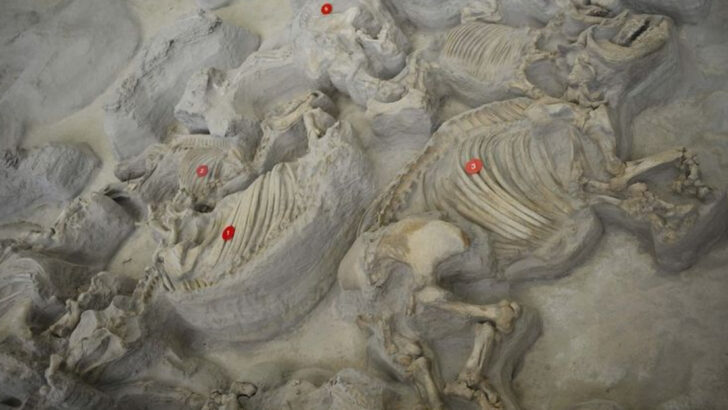Twelve million years ago, Nebraska wasn’t cornfields and cows—it was a wild, ash-covered graveyard.
And the animals? They didn’t stand a chance.
A volcanic eruption, hundreds of miles away, rained death across the plains. Herds of rhinos, camels, and three-toed horses collapsed mid-step, their final moments frozen in time beneath a suffocating blanket of ash.
Today, near a quiet trickle called Verdigre Creek, their bones lie perfectly preserved—jaws agape, limbs twisted, like they were caught in a slow-motion disaster movie. Paleontologists call it Ashfall. We call it prehistoric drama at its finest.
This isn’t just dirt and bones. It’s a front-row seat to a moment the world forgot. And it’s begging to be uncovered.
Rhino Fossil

Imagine a world where rhinos roamed the vast plains of Nebraska. At Ashfall Fossil Beds, a well-preserved rhinoceros fossil captures this reality. The fossil reveals the entire skeleton blanketed by volcanic ash, offering an unparalleled glimpse into the Miocene epoch. These majestic creatures once thrived in the region, their massive frames adapted to the ancient environment. The discovery provides insights into their diet and lifestyle. Did you know that these rhinos are distant relatives of today’s species? Their presence in Nebraska highlights dramatic shifts in climate and geography over millions of years.
Three-Toed Horse Fossil
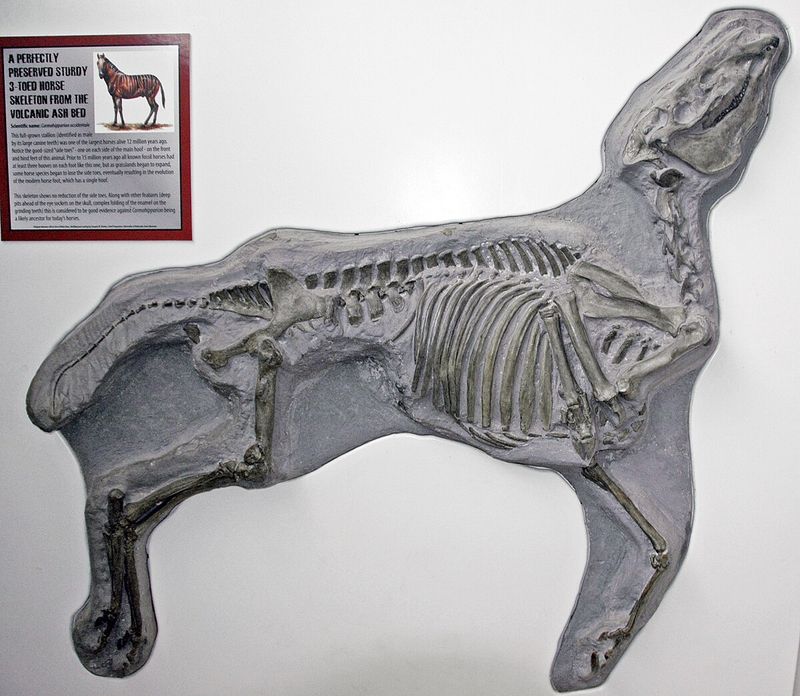
Step back in time with the three-toed horse, an ancestor to modern equines. The Ashfall Fossil Beds preserve these intriguing fossils, illustrating a creature smaller than today’s horses. Their distinctive three-toed limbs allowed adaptability across diverse terrains. Found encased in ancient ash, these fossils paint a vivid picture of life 12 million years ago. The three-toed horses’ presence suggests lush, varied landscapes once existed in Nebraska. It’s fascinating how these creatures evolved, eventually leading to the single-toed horses we know today. Their legacy highlights evolutionary adaptability and environmental changes.
Saber-Toothed Deer Fossil

The saber-toothed deer, with its unique elongated canines, stands out among Nebraska’s prehistoric fauna. Discovered at Ashfall Fossil Beds, this fossil showcases unusual adaptations for defense and foraging. Encased in ash, it offers a rare window into Miocene life. Unlike modern deer, these creatures had pronounced saber-like teeth, possibly used for display or combat. Their fossils provide clues about competing species and ecosystems. Despite their fearsome appearance, saber-toothed deer were primarily herbivores. Their striking features remind us of nature’s diverse evolutionary paths and the dynamic environments of ancient Nebraska.
Tortoise Fossil
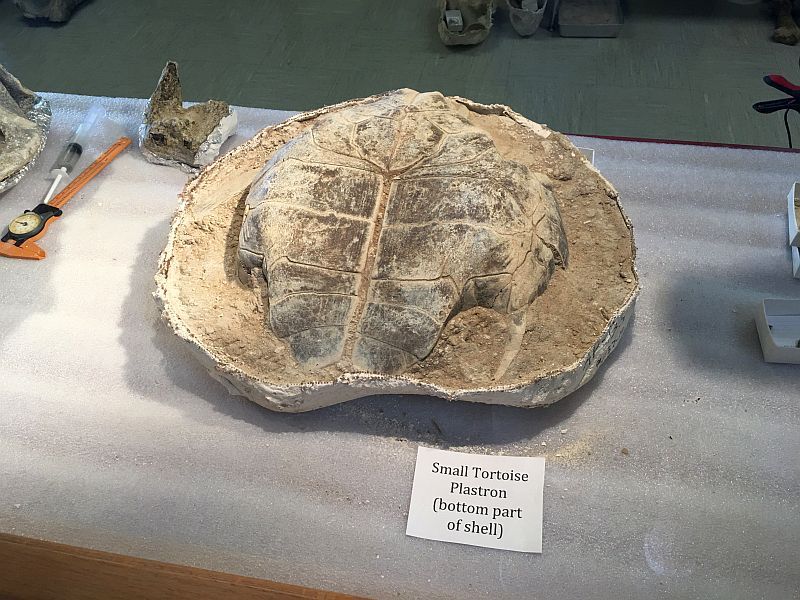
Beneath layers of ancient ash lies a remarkable tortoise fossil, emblematic of Nebraska’s prehistoric past. These gentle giants once inhabited the region, their large shells a testament to their slow, steady lifestyle. The Ashfall Fossil Beds preserve these creatures exceptionally well, providing insights into their habitats and survival strategies. Tortoises thrived in the Miocene’s warm climate, their fossils illustrating a bygone era when Nebraska’s landscapes were vastly different. Did you know tortoises have existed for millions of years, adapting to various climates? Their survival story is a testament to resilience and adaptation.
Crocodile Fossil
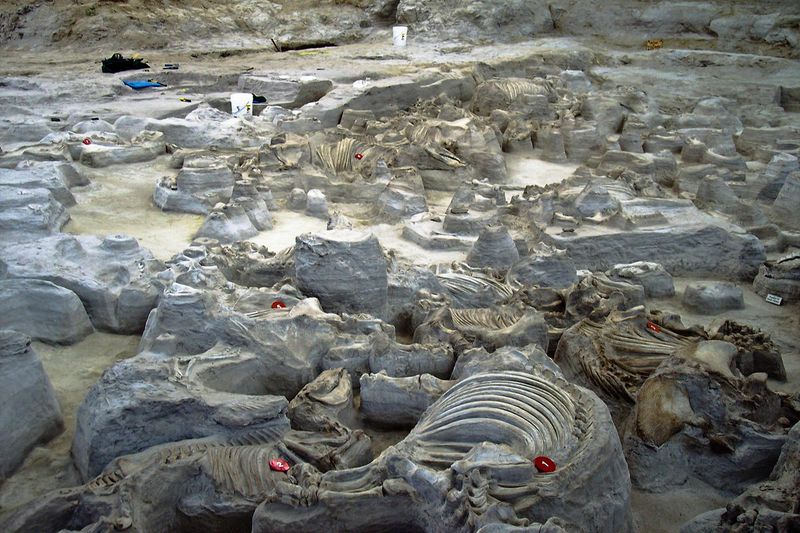
Amidst Nebraska’s fossil treasures, a crocodile fossil emerges, revealing a predatory past. This ancient crocodile, preserved in the Ashfall Fossil Beds, showcases formidable jaws and a sleek body. These reptiles thrived in Nebraska’s prehistoric waterways, adapting to changing environments. The fossil’s preservation in ash captures an ecological snapshot of the Miocene epoch. Crocodiles, with their impressive longevity as a species, highlight gradual evolutionary processes and shifts in climate. Their existence in Nebraska might surprise some, yet it underscores the state’s dynamic ancient ecosystems. Crocodiles’ adaptability is a marvel of natural history.
Camel Fossil
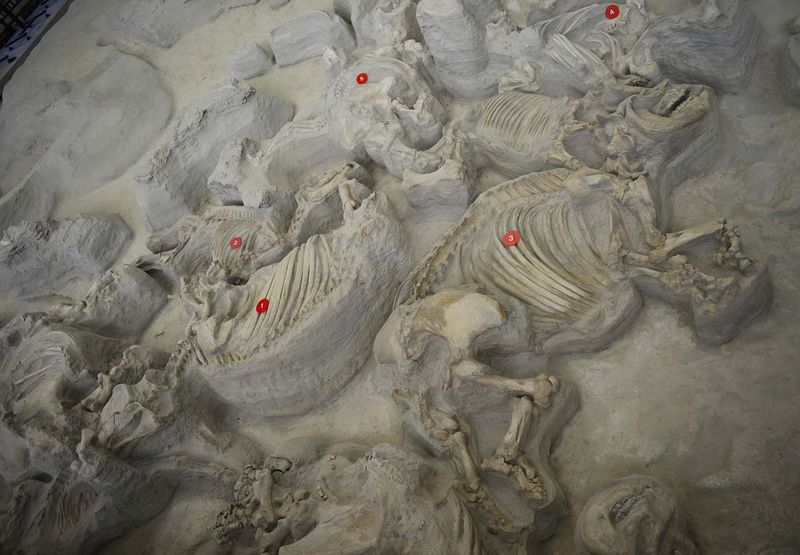
In an unexpected twist, camels once roamed Nebraska’s ancient landscapes. The Ashfall Fossil Beds unveil these remarkable creatures, their fossils offering insights into their lives. Unlike modern camels adapted to desert environments, these ancestors lived in lush plains. Their long limbs and necks indicate adaptability to diverse habitats. The fossil discovery at Ashfall provides a unique perspective on Nebraska’s prehistoric climate and fauna. Did you know camels originated in North America? Their migration and evolution tell a story of survival and change, painting a picture of a dynamic, interconnected prehistoric world.
Bird Fossil
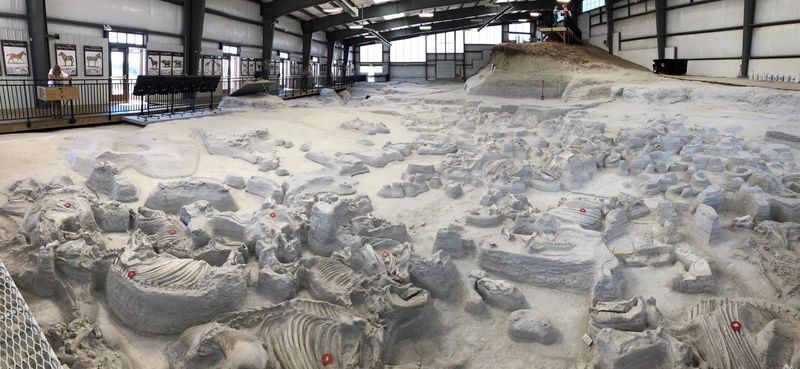
Nebraska’s Miocene skies were once filled with diverse avian life. Bird fossils at Ashfall Fossil Beds capture this vibrant past. These delicate fossils showcase intricate wing structures and varied species, from waterfowl to predatory birds. Encased in ash, they provide a rare glimpse into flight and behavior millions of years ago. Birds played crucial roles in ancient ecosystems, their fossils a testament to adaptability and survival. Did you know some birds had wingspans rivaling modern eagles? Each fossil tells a story of evolution and environmental shifts, enriching our understanding of Nebraska’s prehistoric biodiversity.

